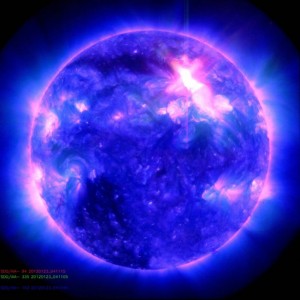Will Aurora Grace New England Sky?
Posted by Noelle Swan Eyes turn to the sky as scientists and citizens alike hope radiation from a solar flare on Monday morning brings a rare view of the northern lights.
Eyes turn to the sky as scientists and citizens alike hope radiation from a solar flare on Monday morning brings a rare view of the northern lights.
The surprise flash of solar activity launched energetic particles through space at near light speeds. Those particles lit up the sky over the U.K. last night and continued to bathe much of the globe today as astrophysicists warned of possible satellite disruptions.
While much of this solar storm is passing over during the day, a small chance remains that New Englanders might also get a glimpse of the spectacular aurora borealis, usually seen only in northern latitudes, says Nathan Schwadron, space plasma physics professor at University of New Hampshire.
Schwadron watched the solar flare from his laptop via UNH’s Cosmic Ray Telescope for the Effects of Radiation. “We were sort of watching this happen late into the night and into the morning. We had a flare that went off that was the largest flare we’ve seen so far this solar cycle.” Schwadron said that the size of the flare sent him frantically comparing the event unfolding on his monitor with some of the largest events observed in the past in hopes of predicting what might happen after the flare. He compared the event to one in 2003, the so-called “Halloween storms” that began with a flare very similar to this one but continued as 8 or 9 more flares came three days later.
Scientists are calling this flare the biggest since 2005, just shy of earning the designation X-flare, the most powerful kind. Still, Schwadron cautions, “There’s still a chance that this event could develop and become even worse, but so far it’s looks like a pretty isolated event.”
Even without further activity, this flare could potentially result in some damage to hardware. When a shock wave of particles sweeps around the earth, it can interfere with satellites. Snow, as seen with poor television reception, can cloud imaging satellite output. Communication satellites can also be disrupted, particularly near the poles.
In the past, geomagnetic storms have caused disruptions in global satellite positioning systems, cell phones, and power grids. In some cases air traffic control has had to reroute flights scheduled to fly over the poles.
This time around at least, it appears that disruption to daily lives remains minimal driving attention to the more spectacular effect of the solar storm—aurora borealis. For the northern lights to appear outside of their usual realm, a number of factors must align perfectly, including orientation of the earth’s magnetic field and configuration of the shock wave engulfing the Earth, making it difficult for scientists to predict where they will appear.
Due to the timing of this particular event, Schwadron expects that the southern hemisphere will most likely get the best view of the light show. He expects that much of shock will have already passed over New England before nightfall, but urges residents to take a peek up at the night sky, just in case.
Related posts:
- On the Right Track: Vermont-based Renewable Energy Company Makes its “AllSun Trackers” Available Throughout Northern New England
- There’s A Cure For That: A Look At New England’s Most Recent Medical Breakthroughs
- Vogue’s Grace Coddington telling her story
- State-by-State Look at Dangers in New England, Prep for Irene
- AllEarth Renewables has its Moment in the Sun; the Vermont-based Company’s ‘AllSun Tracker’ Selected as a Top 10 Green Product for 2012
Short URL: http://www.newenglandpost.com/?p=8791








